What's New
Displaying results 2951 - 2960 of 4052

Resource | Publications,
A cross-sectional survey was administered among 1,022 female sex workers (FSW) recruited from 9 different types of commercial sex venues in Southwest China. Partner violence scales were adapted from WHO’s Women’s Health and Domestic Violence scale and psychosocial distress was measured by five indicators, including alcohol intoxication, drug use, suicidal behavior, depression, and loneliness.
This study is one of the first to examine the association between partner violence and psychosocial distress among FSW in China. The high prevalence of violence experience and distress in this population suggests urgency for intervention. The public health programs targeting FSW should go beyond the focus on HIV/STI prevention and care for the fundamental health and human rights of millions of FSW in China.
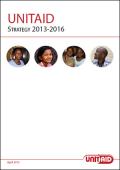
Resource | Publications,
With this new Strategy 2013-2016, UNITAID enters what could be called the third stage of its
development.
UNITAID's mission has remained constant over the years. It increases access to treatment for HIV/
AIDS, TB and malaria for people in developing countries by leveraging price reductions of quality drugs and diagnostics, which currently are unaffordable for most developing countries, and to accelerate the pace at which they are made available.
The UNITAID Strategy 2013-2016 provides an excellent vision that will guide new investments. It
identifies the tools needed to implement the Strategy, of which many are already under development,
tried and tested. UNITAID remains creative in its approach, and is ready and able to develop new tools or engage in new partnerships that will ensure its objectives are met. UNITAID’s innovative source of income will continue to be well invested, and UNITAID will strive to increase its funding capacity through new and existing donors.
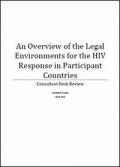
Resource | Reviews and Snapshots,
very country has a unique legal environment that will dictate whether and how the HIV response might be incorporated into legislation. New or amending laws should be tailor-made for the specific legal environment that exists.
Already existing in each country is a body of both primary (Laws, Acts and Decrees) and secondary laws (such as Regulations and Orders). The legal environment includes the Constitution (as the supreme Law of the country) and the constitutional protections provided by it.
In preparation for the UNAIDS Pacific Consultation on Legal and Policy Barriers to Accessing HIV Services for PLHIV and Key Affected Populations held in Nadi, Fiji from 17-19 April 2013, the author was commissioned as a consultant to conduct a desk review of the available national laws and legislative policies impacting HIV responses in the participant countries: Fiji, Kiribati, Papua New Guinea, Samoa, Solomon Islands, Tuvalu and Vanuatu.
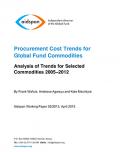
Resource | Publications,
The Global Fund has approved over $22.9 billion in grants for HIV, TB and malaria programmes since 2002. Nearly 40% of the money has gone towards procurement, making the Global Fund a major player in the market for commodities. With such leverage, the Fund is always looking to influence prices.
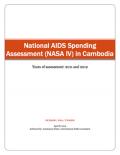
Resource | Publications,
This round of the National AIDS Spending Assessment (NASA IV) follows the same methodological approach which has been applied in the NASA III and described in the NASA III report.
NASA team always aims to collect expenditure data from all actors of the response. These organizations – actors of the HIV response – are playing different roles in different transactions, either financial or in-kind. The organization acts as a Financing Source when it makes money available for the country’s HIV response. It transfers funds to the other organizations who decide what should be implemented and who will be implementing. This role is a role of a Financing.
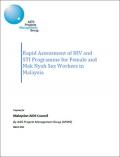
Resource | Publications,
The main finding from this assessment is that the Global Fund program me has contributed towards significant coverage of the population and has provided an opportunity for Malaysian NGOs to design and work towards delivering a comprehensive package of services for the sex worker population in the last one and half years. In all sites visited, there was strong evidence of the impact of the intervention in the SW community, the high commitment of the SRs to the project, and evidence of greater community understanding and acceptance of the importance of HIV prevention in the project sites.
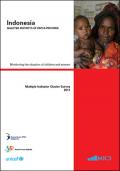
Resource | Publications,
The Selected Districts of Papua Province Multiple Indicator Cluster Survey (MICS) was carried out in 2011 by Badan Pusat Statistik (BPS) under the leadership of the National Development Planning Agency (BAPPENAS) and the Ministry of Home Affairs. Financial and technical support was provided by the United Nations Children’s Fund (UNICEF).
MICS is an international household survey programme developed by UNICEF. The Selected Districts of Papua Province MICS was conducted as part of the fourth global round of MICS surveys (MICS4). MICS provides up-to-date information on the situation of children and women, and measures key indicators that allow countries to monitor progress towards the Millennium Development Goals (MDGs) and other internationally agreed upon commitments.
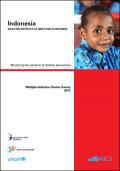
Resource | Publications,
The Selected Districts of West Papua Province Multiple Indicator Cluster Survey (MICS) was carried out in 2011 by Badan Pusat Statistik (BPS) under the leadership of the National Development Planning Agency (BAPPENAS) and the Ministry of Home Affairs. Financial and technical support was provided by the United Nations Children’s Fund (UNICEF).
MICS is an international household survey programme developed by UNICEF. The Selected Districts of West Papua Province MICS was conducted as part of the fourthglobal round of MICS surveys (MICS4). MICS provides up-to-date information on the situation of children and women, and measures key indicators that allow countries to monitor progress towards the Millennium Development Goals (MDGs) and other internationally agreed upon commitments.
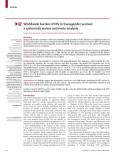
Resource | Publications,
Previous systematic reviews have identified a high prevalence of HIV infection in transgender women in the USA and in those who sell sex (compared with both female and male sex workers). However, little is known about the burden of HIV infection in transgender women worldwide. We aimed to better assess the relative HIV burden in all transgender women worldwide.
Our fi ndings suggest that transgender women are a very high burden population for HIV and are in urgent need of prevention, treatment, and care services. The meta-analysis showed remarkable consistency and severity of the HIV disease burden among transgender women.

Resource | Presentations,
Sexually transmitted infections (STIs) are major causes of reproductive morbidity (pain, infertility) and mortality (HIV) usually concentrated in Most at Risk Populations (MARPs), characterized by frequent, unprotected sexual intercourse. Measuring risk behaviors, protective behaviors and prevalence of STI among MARPs allows for monitoring the impact of treatment & preventive interventions.





